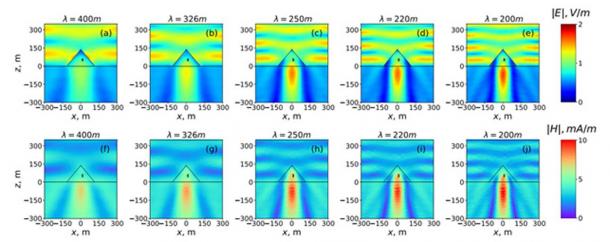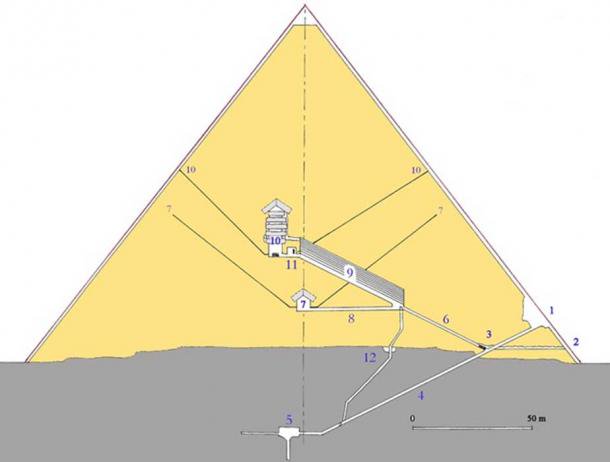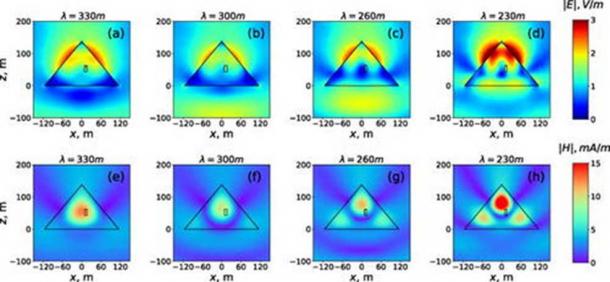by Ashley Cowie; Ancient Origins
The Great Pyramid of Giza is without question the most famous building of the ancient world. Completed around 2560 BC during the reign of Pharaoh Khufu, this enigmatic monument is a central feature in the larger Giza pyramid complex with two smaller pyramids, many other vast temples and tomb.
For over 50 years alternative historians have postulated that this magnificent building was designed specifically to harness and generate some sort of energy, which of course scientists and archaeologists find no evidence of. But reading this week’s headlines, new agers must be bouncing in their seats as a team of physicists has announced that, “under the right conditions, the Great Pyramid can concentrate electromagnetic energy in its internal chambers and under its base” according to a paper published in the Journal of Applied Physics.

Distribution of electromagnetic waves inside the pyramids of Cheops at different lengths of radio waves (from 200 to 400 meters). The black rectangular position of the so-called King’s Chamber. (Image: ITMO University , Laser Zentrum Hannover )
Newsweek reported that results of this study could help scientists to “create new nanoparticles—particles between 1 and 100 nanometers in size” that might be used to “develop highly efficient solar cells or tiny sensors.” Although this news will be interpreted by some as evidence of prehistoric lost sciences and extraterrestrial intervention, nothing in this scientific study suggests anything of the sort.
The team of theoretical physicists from ITMO University in Saint Petersburg, Russia, and the Laser Zentrum in Hannover, Germany, investigated the Great Pyramid’s response to electromagnetic radiation including microwaves, radio waves and infrared, but also visible light, ultraviolet light, X-rays and gamma rays. “We wanted to find out what peculiarities of electromagnetic energy distributions can be obtained in the pyramid and environment under the condition of its strong interaction with electromagnetic waves,” Andrey Evlyukhin, an author of the study from ITMO, told Newsweek.
In layman’s terms, the scientists applied theoretical methods normally used in the study of optics where light is scattered by nanoparticles and the electromagnetic properties are measured. Evlyukhin told reporters that he was thrilled to have worked on the Great Pyramid of Giza which he said was “one of the most intriguing objects in history.”
 Inner structure of the Great Pyramid of Khufu. ( Public Domain )
Inner structure of the Great Pyramid of Khufu. ( Public Domain )
The scientists were able to calculate that when subjected to wavelengths between 656 and 1,968 feet (200 and 600 meters) the pyramid “resonated” – meaning the structure scattered and absorbed much more energy from electromagnetic waves than other bandwidths, according to Evlyukhin. He told reporters that his results could “provide us with new and important information which will be useful in nano-optics for the design of nanoparticles with required optical properties.”
The project began by generating computer models of how the radio wave energy would be scattered or absorbed in “resonant” states, revealing that the pyramidal structure focused electromagnetic energy in its “internal chambers and under its base.” However amazing all this is beginning to sound, beware, for this is not an exact science and a lot of assumptions were made, and we all know what they do!
Because over 95% of the pyramid is unobservable the scientists had to make a string of educated guesses as to its physical properties, which greatly affect results. For example, not only do rock types effect the flow of magnetic waves, but so does space, and it was assumed that there are no further cavities within its structure. And so far as estimating the building material used, the scientists ‘assumed’ ordinary limestone was evenly distributed throughout the monument. Distributions of electric (a)–(d) and magnetic (e)–(h) field magnitudes in the x-z plane of the Pyramid located in the free space. (Image: ITMO University , Laser Zentrum Hannover)
Distributions of electric (a)–(d) and magnetic (e)–(h) field magnitudes in the x-z plane of the Pyramid located in the free space. (Image: ITMO University , Laser Zentrum Hannover)
This study reveals the unusual electromagnetic properties of the Great Pyramid of Giza, and where many reporters are calling these findings an ‘accident’, I disagree. They are not ‘accidental’, they are axiomatic, self-evident, and result from the size, scale and shale of the building. If it was smaller or larger, these results would be different, yet a faction of people will insist the pyramid was built ‘deliberately’ as it was, specifically to generate and harness the waveband which resonates the pyramid.
Now, you can follow Conscious Reminder on INSTAGRAM!
∼If you like our article, give Conscious Reminder a thumbs up, and help us spread LOVE & LIGHT!∼
